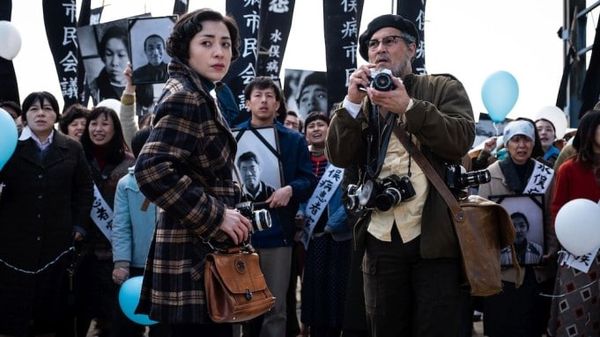Eye For Film >> Movies >> Minamata (2020) Film Review
Minamata
Reviewed by: Jennie Kermode

There comes a point in every conventionally beautiful actor’s career when age begins to rob them of the looks on which they were once sold. For some, it leads to panic and a grasping after youth which yields increasingly embarrassing results. For others, it is a moment of liberation. No longer required to focus on looking attractive, they are free to focus on developing and expressing their characters as never before. It’s a moment when we find out what they’re really made of.
For Johnny Depp, that moment has come with Minamata. With a tangled mass of curly, greying hair and coarse stubble, he wears thick glasses and bears liver-spotted skin. Every effort has been made to conceal those famous cheekbones. it’s not him we’re supposed to be looking at, but rather what he sees.
When aiming to re-establish one’s ability and win audience sympathy, nothing beats playing a real person. In this case that person is W Eugene Smith, a Wichita-born war photographer who spent many years working for Life magazine but is best known for the photographs he took in the small Japanese town of Minamata in 1971. Events surrounding his decision to go there have been significantly altered in this film, which has wisely chosen to downplay his whirlwind romance with Aileen (Minami) a translator 31 years his junior (it is acknowledged but kept in the background). Here he is presented as a broken man, haunted by the memory of traumatic incidents he has witnessed in the past. He’s estranged from his children, drinks heavily and is prone to running away from anything which looks too much like responsibility, but he’s a man searching for a purpose, and in Minamata, he just might find one.
Though it has gone on to reinvent itself and has won several ecological awards, the name of Minamata looms large in the public imagination, alongside the likes of Bhopal and Flint. Its tragedy was entirely avoidable, a consequence of chemical giant Chisso Corp allowing factory waste to leak into the surrounding waters for over a decade, with dramatic consequences for the health of the local population. Unable to get help from local sources of authority, the affected people turned to the American photographer in the hope that he could generate some international pressure. As soon as he arrives in the area, we can see that the situation moves him. This in itself has a significant effect on the attitude of the locals, as his different cultural background means he doesn’t buy into the sense of shame and dishonour traditionally associated with disability in Japan. His role becomes not merely to record events but to help them put that shame where it really belongs.
Is this a white saviour story? If so, Depp’s shambling, befuddled figure, overtly obnoxious when able to secure enough whisky, makes for an unlikely hero. He seems in dire need of saving himself, and it’s this that gives the film balance. Director Andrew Levitas is careful not to allow him too much sympathy, observing how, though he knows better, he has to be prompted to remember basic courtesies like taking off his shoes or bowing when expressing thanks. What he brings to the town is his talent, his connections in the world of publishing and his experience of other confrontational situations. He will be in need of the latter when Chisso starts to play rough.
Though the film is centred firmly on Depp, Minami gets to put across a lot more personality and show a lot more resourcefulness than we might ordinarily expect from a love interest or assistant. There’s also strong support from Hiroyuki Sanada as the leader of the group opposing Chisso’s activities, whilst Bill Nighy brings a concentrated version of his world weary act to bear as the editor dealing with Gene at the other end. Levitas’ directorial style leaves something to be desired, with the action getting hard to follow in crowd scenes where we really need to know what’s going on, but there are some interesting editorial decisions, notably in the use of old film clips of real people and cats affected by ‘Minamata disease’, which are spliced into the film at key moments and remind us of the real gravity of the situation. The recreations of real photographs are nicely staged, albeit a little uncomfortable in light of the fact that at least one of the families involved had previously asked for one of those images to be withdrawn.
With Minamata itself looking very different today, the film was mostly shot in Serbia, which does a surprisingly good job of standing in for rural Japan. It’s aided by Ryuichi Sakamoto’s highly evocative score, which locates it in time and space as well as providing a dramatic undercurrent to the action. Warmly received in Japan, where the issue of what happened in Minamata remains politically volatile to this day, the film aims to reach outwards and address wider issues around industrial pollution. Whilst it doesn’t manage to take this very far at a narrative level, one hopes that the pictures will speak for themselves.
Reviewed on: 14 Dec 2021

















